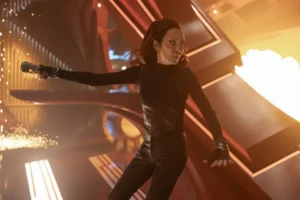Folger Theatre’s Amadeus: Review

Image courtesy of The Washington Post
By Garrett Farrell
If you are, like me, accustomed to the grandeur of Broadway, walking into the Folger Theatre is a somewhat strange experience. Instead of imposing chandeliers and rows upon rows of seats, the Folger is a small theatre, not seating more than four hundred people, even though the show played to a sold-out audience. This distinct atmosphere of intimacy creates the perfect effect for their production of Amadeus, which runs from November 5 until December 22.
The first thing that must be noted about the production was Tony Cisek’s brilliant production design. The stage perfectly mimicked the interior workings of a harpsichord, a personal favorite instrument of Mozart’s, and perhaps the perfect metaphor for the story that unfolded on the stage; one that was as complex and as glorious as the music that the titular composer wrote.
The story is one of intrigue from its beginning: the audience was immediately lured into the story by the claim from one Antonio Salieri, who said that he had poisoned Mozart. From there, there is a flashback to 32 years prior, to the first time Salieri was ever introduced to the music of Mozart, and thus began a tale of deception and bilking that would put modern American politics to shame. The story was brilliantly carried on the shoulders of Ian Merrill Peakes and Samuel Adams who played Salieri and Mozart, with excellent support from the remainder of the actors in the company. The performances of the actors were underscored by the radiant lighting design of Max Doolittle.
With a score provided using Mozart’s compositions, the production was nearly complete: nearly. The only thing that left something to be desired was the writing.
Though a perfectly adequate way of conveying the story, the play clocked in at an astounding three hours long, with a wit that was simply not up to par in modern drama. Though the dialogue was written in a way that helped the audience sympathize with both Mozart and Salieri well, it was very repetitive, as Mozart often uses less dignified words for human excrement. Ultimately, the dialogue was an acceptable concession to make for the play. What was most intriguing, however, was the stories the play seemed to tell about all ages of Man.
“In Europe, the political tectonic plates were shifting… Against this backdrop, Schaffer created a modern Revenge Comedy’,” said director Richard Clifford in his note to the audience.
This concept set the stage perfectly for the main theme that the play developed, the conflict between generations. The first act was almost exclusively dedicated to this theme. At the beginning of the play, Salieri attempted to “summon” the audience using an invocation. This was immediately followed by Salieri stating that an invocation used to be the purpose of attending an opera and that now, in 1823, people go solely to hear tales “about a prattling hairdresser,” a slightly anachronistic shot at Rossini’s Barber of Seville.
The remainder of the play followed a similar pattern; upon hearing and meeting Mozart, both Salieri and the rest of the court Emperor Joseph II (John Taylor Phillips) keeps in Vienna were quick to dismiss him as brash and childish, and even critique his compositions according to this sentiment (Salieri confessed that the music was indeed exceptional in an aside to the audience). The conflict between the generations came to a head at the premiere of Mozart’s first opera, where the older generation stuck their noses up at a work that was regarded as one of his finest.
On this occasion, the director made what seemed a rather conscious decision to have Mozart wearing a blue wig in what may very well be a reference to the conflict between Millennials and Baby Boomers. This connection was seemingly amplified by a later conversation Mozart had with the court members about this subject matter, in which he exclaimed: “Opera celebrates the eternal in all of us.” This expression was given in support of Mozart proposing a radical change to what opera traditionally celebrates: man instead of gods, mundane instead of divine, duels with swords instead of the forces of nature.This inclination towards a social change of sorts can easily be read as identifying Mozart with a generation that is generally more active than those which came before it. Naturally, this furthers the case of Amadeus being a tale of the conflict between generations. This theme, however, has something of a corollary to it: there will always be works whose greatness unites generations, and there is no gap that cannot be bridged by great art.







